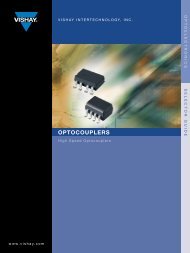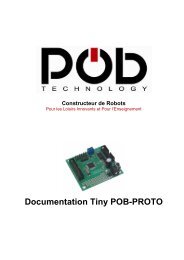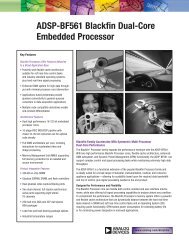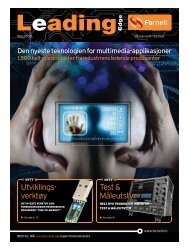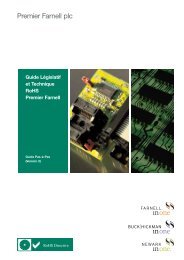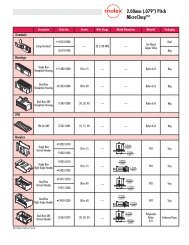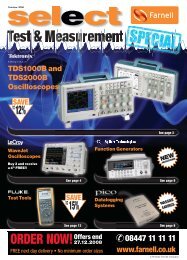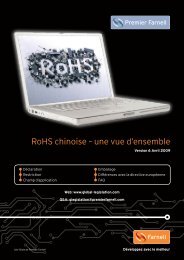LPC213x family - Farnell
LPC213x family - Farnell
LPC213x family - Farnell
You also want an ePaper? Increase the reach of your titles
YUMPU automatically turns print PDFs into web optimized ePapers that Google loves.
<strong>LPC213x</strong> <strong>family</strong> Tiny 32-bit ARM7TDMI-S <br />
These tiny ARM-based microcontrollers, optimized for low<br />
power consumption, improve performance in a variety of<br />
industrial, medical, communication, and general-purpose<br />
applications. Integrating 512 KB of on-chip Flash, up to<br />
32 KB of on-chip RAM, and up to two 10-bit ADCs.<br />
Key Features<br />
• 60-MHz operation from single-chip 32-bit ARM7TDMI-S processor<br />
– LPC2131 with 32KB Flash, 8KB RAM, 1x 10-bit ADC, and lowpower<br />
options<br />
– LPC2132 with 64 KB Flash, 16 KB RAM, 1x 10-bit ADC, 10-bit DAC,<br />
and low-power options<br />
– LPC2134 with 128K Flash, 16 KB RAM, 2x 10-bit ADC, 10-bit DAC,<br />
and low power options<br />
– LPC2136 with 256K Flash, 16 KB RAM, 2x 10-bit ADC, 10-bit DAC,<br />
and low power options<br />
– LPC2138 with 512 KB Flash, 32 KB RAM, 2x 10-bit ADCs, 10-bit DAC,<br />
and low-power options<br />
• Optional 16-bit Thumb Mode for critical code-size applications<br />
• Very fast Flash programming via on-chip boot-loader software<br />
• Two 32-bit timers, PWM unit, real-time clock, watchdog timer<br />
• Multiple serial interfaces: two UARTs, two Fast I2C-bus, two SPI<br />
• Temperature range: -40 °C to +85 °C<br />
• Tiny HVQFN64 or LQFP64 package (9 mm x 9 mm or 10 mm x 10 mm)<br />
Applications<br />
• Access control, point-of-sale, industrial control, medical systems<br />
• Communication gateways, protocol converters, embedded soft modems<br />
• General-purpose applications<br />
processors with ADC and DAC<br />
Semiconductors<br />
These 32-bit ARM7TDMI-S microcontrollers, housed in tiny LQFP or<br />
HVQFN packages, use a 128-bit-wide memory interface and a unique<br />
accelerator architecture to enable 32-bit code execution at a maximum<br />
clock rate of 60 MHz. For code-size critical applications, they use an<br />
alternative 16-bit Thumb Mode that reduces code by more than 30% with<br />
minimal performance penalty.<br />
The initial part in the <strong>family</strong> is the LPC2138. Optimized for low-power<br />
operation, it has 512 kB of Flash and 32 kB of SRAM. There are two<br />
8-channel 10-bit A/D converters (for a total of 16 analog inputs) with conversion<br />
times as low as 2.44 µs per channel. It has a 10-bit D/A converter<br />
for generating variable analog outputs and offers up to forty-seven 5Vtolerant<br />
GPIO. It uses a single power supply with POR (Power On Reset)<br />
and BOD (Brown Out Detection) circuits. The real-time clock uses independent<br />
power and clock supplies, so power consumption in the powersave<br />
modes is extremely low. It has a CPU operating voltage range of 3.0V<br />
to 3.6V (3.3V ±10%).<br />
In-System (ISP) and In-Application (IAP) software minimize programming<br />
time — each 256-byte line takes only 1 ms to program, while single selector<br />
or full-chip erases take only 400 ms.<br />
It has a Vectored Interrupt Controller (VIC), and uses Embedded ICE-RT<br />
and ETM (Embedded Trace Macrocell) to provide extensive, real-time<br />
debug capabilities.<br />
There are two 32-bit timers (with four capture and four compare channels<br />
each), a PWM unit (with 6 outputs), a real-time clock, and a watchdog<br />
timer. Multiple serial interfaces, including two UARTs (16C550), two Fast<br />
I2C (400 kbps) and two SPI serial interfaces (one with buffering and variable<br />
data-length capabilities), increase design flexibility.
<strong>LPC213x</strong> <strong>family</strong><br />
Tiny 32-bit ARM7TDMI-S processors with ADC and DAC<br />
32 / 64 / 128 / 256 /<br />
512 KB ISP IAP<br />
128-b wide FLASH<br />
8 / 16 / 32 KB<br />
SRAM<br />
Capture / Compare<br />
Timer 0 / 1<br />
UART1<br />
(Modem Control<br />
LPC2138/2136/2134 only)<br />
AHB Interface<br />
32-bit ARM7TDMI-S APB Interface<br />
Purchase of Philips I 2 C components conveys a license<br />
under the Philips' patent to use the components in<br />
the I 2 C system provided the system conforms to the<br />
I 2 C specification defined by Philips.<br />
E-ICE / RTM Interface<br />
Embedded Trace<br />
Power Management, RTC, WDT, PLL<br />
2 x 8 Channel 10-bit A/D Converter (LPC2134, LPC2136 and LPC2138)<br />
1 x 8 Channel 10-bit A/D Converter (LPC2132)<br />
1-Channel 10-bit DAC (no DAC on LPC2131)<br />
UART0<br />
<strong>LPC213x</strong> block diagram<br />
I/O Ports (47)<br />
Vectored<br />
Interrupt<br />
Controller<br />
PWM<br />
2 x I 2 C<br />
SPI 0, 1<br />
www.semiconductors.philips.com<br />
Third-party development tools<br />
Through third-party suppliers, Philips offers an extensive portfolio of<br />
development tools for these microcontrollers. For the most current listing,<br />
please visit www.semiconductors.philips.com/markets/mms/products/<br />
microcontrollers/support/development_tools/ for the most current list of<br />
available tools.<br />
Development tool support selection<br />
Tool Name<br />
Emulators<br />
Vendor<br />
Multi-ICE ARM<br />
MultiTrace ARM<br />
RealView ICE ARM<br />
Genia Ashling<br />
Opella Ashling<br />
Vitra Ashling<br />
Tanto Hitex<br />
j-link IAR Systems<br />
ULINK Keil<br />
TRACE32-ICD Lauterbach<br />
TRACE32-PowerTrace Lauterbach<br />
EMUL-ARM-PC Nohau<br />
JTAGjet Signum<br />
Development & Evaluation Boards<br />
MCB2130 Keil<br />
In-Systems Programming Software<br />
Flash ISP Utility Philips<br />
Philips Semiconductors<br />
Philips Semiconductors is a worldwide company with over 100 sales offices<br />
in more than 50 countries. For a complete up-to-date list of our sales offices<br />
please e-mail sales.addresses@www.semiconductors.philips.com.<br />
A complete list will be sent to you automatically.<br />
You can also visit our website http://www.semiconductors.philips.com/sales<br />
© Koninklijke Philips Electronics N.V. 2005 SCL76<br />
All rights reserved. Reproduction in whole or in part is prohibited without the prior<br />
written consent of the copyright owner.The information presented in this document<br />
does not form part of any quotation or contract, is believed to be accurate and reliable<br />
and may be changed without notice. No liability will be accepted by the publisher for any<br />
consequence of its use. Publication thereof does not convey nor imply any license under<br />
patent- or other industrial or intellectual property rights.<br />
Published in USA<br />
Tool Name Vendor<br />
Integrated Development Environment<br />
ADS ARM<br />
RealView ARM<br />
AsIDE ARM Ashling<br />
MULTI Green Hills<br />
Embedded Workbench IAR Systems<br />
Vision3 Keil<br />
Crossworks Rowley<br />
Monitors/Debuggers/Simulators<br />
PathFinder-2100 Ashling<br />
C-SPY IAR Systems<br />
Vision3 Keil<br />
’Seehau’ Nohau<br />
Universal Debug Engine PLS<br />
Chameleon Signum Systems<br />
Real-Time Operating Systems<br />
ChronOS Interniche<br />
C/OSII<br />
TCP/IP Stacks<br />
Micrium<br />
NicheStack Interniche<br />
Date of release: April 2005<br />
document order number: 9397 750 14627



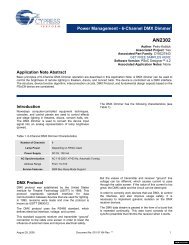
![Microchip Signal Chain Design Guide [pdf] - Farnell](https://img.yumpu.com/19262401/1/190x245/microchip-signal-chain-design-guide-pdf-farnell.jpg?quality=85)
